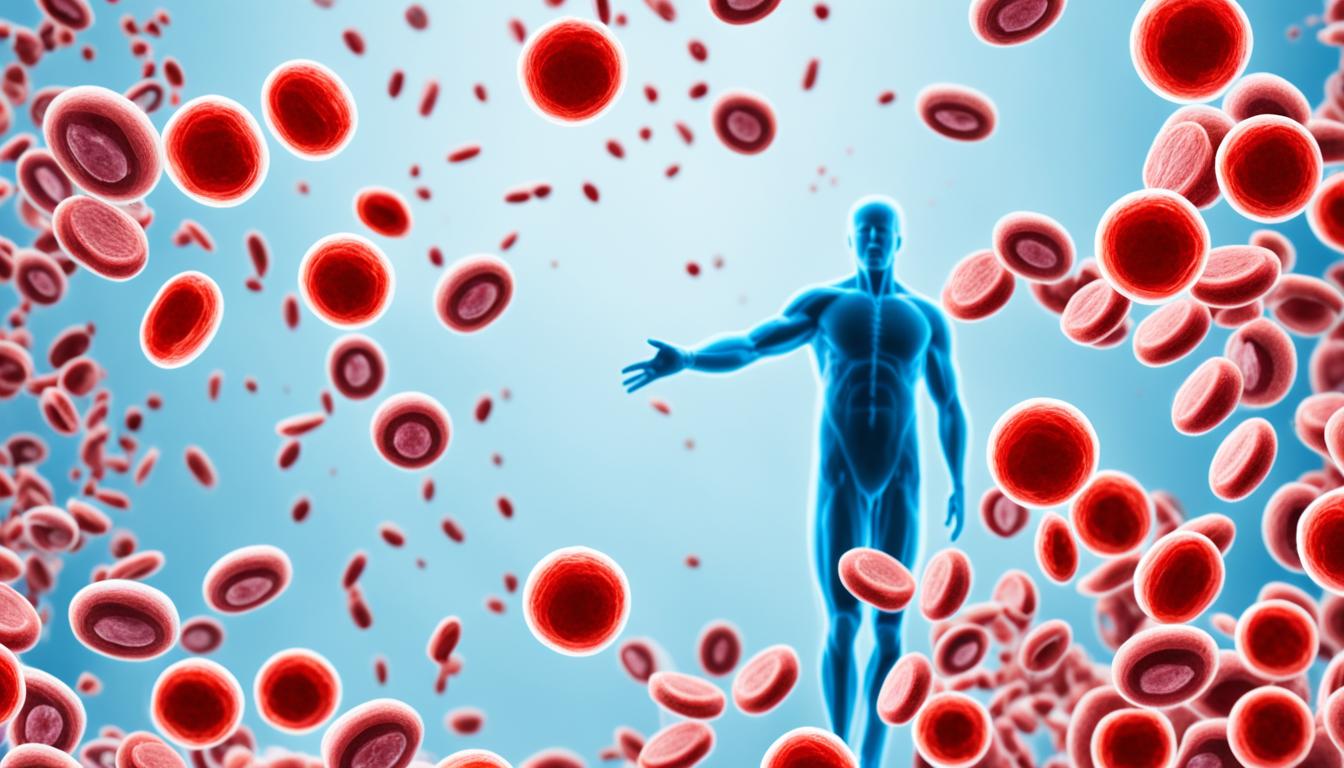Megaloblastic anemia happens when a person doesn’t have enough vitamin B12 or B9. It makes red blood cells bigger than they should be. This condition can cause shortness of breath, muscle weakness, and a pale skin tone. Other symptoms include a swollen tongue, not wanting to eat, and diarrhea.
Doctors can tell if someone has megaloblastic anemia by doing specific tests. These tests check samples of blood and marrow, and measure B12 and folate levels. By doing them, they can see if the problem is really a lack of these vitamins.
Treating this anemia often means giving patients vitamin B12 and folate. This can be through shots or pills. Managing the condition like this helps people feel better and enjoy life more.
Key Takeaways:
- Megaloblastic anemia is characterized by abnormally large red blood cells.
- Vitamin B12 and/or vitamin B9 deficiency are the primary causes of megaloblastic anemia.
- Common symptoms of megaloblastic anemia include shortness of breath, muscle weakness, and pale skin.
- Diagnostic tests such as peripheral blood smear and serum cobalamin can confirm the diagnosis.
- Treatment involves vitamin supplementation and exploratory stem cell therapy.
Causes of Megaloblastic Anemia
Megaloblastic anemia has two key causes: not enough vitamin B12 and lacking folate. Vitamin B12 is crucial for making red blood cells and is mainly in animal products. It needs intrinsic factor, a stomach protein, to be absorbed in our bodies. Without enough intrinsic factor, we can’t get the vitamin B12 we need for healthy cells, leading to this type of anemia.
On the other hand, folate (or vitamin B9) is key for our red blood cells too. It’s in green veggies, fruits, meats, and liver. Low folate levels due to not eating enough or needing more during pregnancy can cause the same anemia. Issues absorbing it or some medications can also play a part in reducing our folate levels.
Also, megaloblastic anemia might not just come from vitamin problems. Drugs like anticonvulsants and treatments for cancer can interfere with blood cell making. Health concerns such as myelodysplastic syndromes or acute leukemia and even not having enough copper can be reasons too. Certain inherited conditions, including thiamine-responsive megaloblastic anemia syndrome, can also lead to this type of anemia.
Knowing the reasons behind megaloblastic anemia is key to find the best treatment. Figuring out what’s causing it helps doctors make a plan that works. They can then treat the real issue, fixing the anemia from the ground up.
Symptoms and Diagnosis of Megaloblastic Anemia
If you have megaloblastic anemia, you might feel tired and weak. You can also have pale skin and a big, swollen tongue. Not wanting to eat, stomach problems, and feeling tinkling or numb in your hands and feet are also signs. These can really change how you live. If you notice these signs, talk to a doctor as soon as you can. They can help figure out what’s happening.
Diagnosis
Doctors have a few tests they use to find out if you have megloblastic anemia. These tests look for special signs that point to this condition. Some tests that help diagnose this type of anemia are:
- Peripheral Blood Smear: Doctors can check a small blood sample under a microscope. This shows if the red blood cells are too big. Finding big red blood cells can be a clue that you have megaloblastic anemia.
- Bone Marrow Biopsy: Sometimes, doctors need to take a small piece of your bone and check it. This helps them see how your body is making red blood cells and if it’s working well.
- Serum Cobalamin and Serum Folate: Blood tests can check your cobalamin (vitamin B12) and folate levels. Low levels of these vitamins can cause megaloblastic anemia.
- Routine Blood Count: A complete blood count test looks at the different parts of blood. If this test is not normal, you might have megaloblastic anemia.
After all the tests are done and your symptoms are checked, doctors can say if you have megaloblastic anemia. It’s key they do all these carefully. This is because understanding the condition well guides how it’s treated.
Once megaloblastic anemia is found, treatment can start. In the next part, we’ll talk about stem cell therapy. It’s a new way to treat this type of anemia.
Stem Cell Therapy for Megaloblastic Anemia and Conclusion
Stem cell therapy is a new way to treat megaloblastic anemia. It’s still under study. Stem cells can turn into different types of blood cells, like red blood cells. This process might help replace the missing red blood cells. It could make the symptoms of megaloblastic anemia better.
Today, we’re learning more about how stem cell therapy might help. Experts see big potential in this method. They believe it might really improve life for people with megaloblastic anemia. Thanks to stem cells, new treatments could be available soon.
In short, megaloblastic anemia makes blood cells larger than normal. This happens when the body doesn’t have enough vitamin B12 or folate. People with this anemia get vitamins to help. But now, with stem cell therapy, there’s new hope. It could change how we care for megaloblastic anemia.

